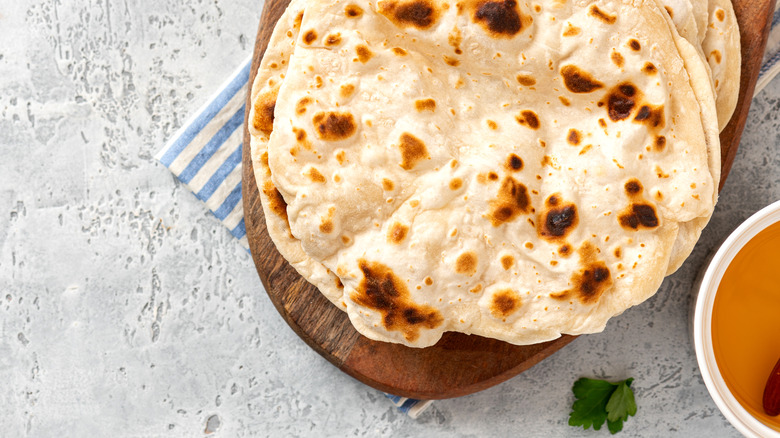What Is Chapati And How Do You Eat It?
While chapati might not be sitting in the store aisle next to the Wonder Bread, this unleavened flatbread can be found on tables from around the world. In a The Kitchn article, the differences and similarities between Indian chapati and Kenyan chapati are explored. For the India version of this flatbread, it seems to be more like a tortilla. According to Taste of Home, the outlet recommends serving the bread with a stew or curry. The thin, crisp bread works well with the sauces in those dishes.
Similar to the Indian version, the Kenyan chapati is often used as both a bread and utensil (via All Things Kenya) While recipes vary, the Los Angeles Times emphasizes the flakiness of this flatbread due to the layers. Although methods vary, the rolled, then flattened dough creates that texture. In addition to the layering aspect, Kaluhi Adagala, a Nairobi-based food blogger, shared in a Medium article, that "the most significant difference between Kenyan and Indian chapati is that Kenyans fry the chapati in ghee or vegetable oil before serving and Indians typically do not."
Whether the flatbread is ripped into pieces, used to soak up a sauce, or even used as base for a wrap, it appears to be a versatile food. From the layers to the texture to the cooking methods, chapati might be a popular flatbread on the table, but not all chapati are the same.
Chapati has evolved through cuisine
Chapati is a food that crosses borders, and its similarities and differences in various cultures can be an interesting food discussion around the table. As explored in an Indian Times article, the impact of Indian diaspora has brought elements of Indian cuisine around the globe. From spices to recipes to a version of flatbread, the article explores how food connects people.
Looking specifically at chapati and Kenya, the Indian flatbread grew in popularity for several factors. As shared in the article, the simplicity of the flatbread had appeal. It only required a pan or a griddle to make it. Add to that element that the bread can be served with stews and curries or enjoyed simply with a cup of tea, cooks seem to have a stack ready to be enjoyed at any time. In some ways, this version of flatbread shows that many cultures have similar foods just with different names. Maybe chapati, tortilla, or just flatbread could be the flavorful bridge to connect people around the table.

